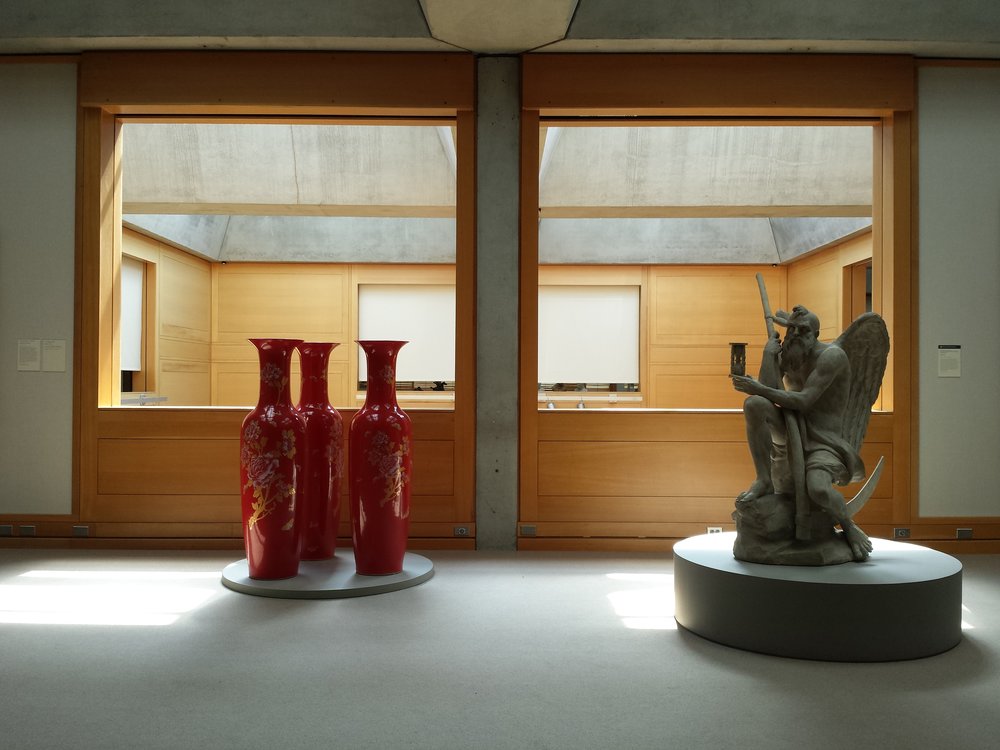
A view from the installation. Stephen Urchick photo.
Clare Twomey’s new installation Made in China makes a splash on Chapel. Her eighty red ceramic vases are scattered liberally across the lobby and through the passageways of the Yale Center for British Art (YCBA). Chest-height and fire-truck bright, touched-up with glittering gold and white transfers, they snag the passing pedestrian’s gaze—a gasp of color from Louis Kahn’s sober façade.
The exhibition opened Aug. 1 and runs through Dec. 3.
Twomey’s vessels turn the entryway into a curbside vitrine. Deeply shaded by its overhanging roof, framed by plate-glass windows, the YCBA’s entrance long had the makings of a giant display case, a fishtank. The London-based visual artist takes advantage of the likeness. She has spread a thicket of porcelain inside this natural vanishing point, counting on a desire to peek and peer and climb inside the receding British Art box.
Twomey offers up a foretaste of Made in China’s companion exhibit, Things of Beauty Growing: British Studio Pottery, due to arrive at the Center this September. The vases blankly broadcast the YCBA’s upcoming focus on 20th century ceramics, but they also anticipate how we’ll likely see those things of beauty: sadly set behind clear acrylic cubes, mostly for their own safety. Twomey herein realizes a fantasy of access with Made in China’s scale. She allows us to circle, to pass between, to get up close and personal with pottery our own size. Sharing the space of the vases, we learn about her art as much with our moving bodies as with the eyes alone.
In remapping the visitor’s physical relationship to ceramics, Twomey also landscapes the YCBA. Made in China’s vases carve up the museum’s big blank entryway. They call out the diagonal line from front door to front desk, but also lay out a meandering, comma-like c-curve back and past the two, perennial Barbara Hepworth sculptures, around Samson as he slays a Philistine.
Hepworth’s ancaster stone sculpture, in particular, acts like a garden ornament. It rightfully becomes a place to stop, linger, and contemplate. Framed by a small stand of vases on the right and one alone out on the left, it punctuates Made in China’s glinting red hedgerow. The vases bring visitors to an artwork that might otherwise be overlooked, inviting us to briefly stroll elsewhere instead of onwards and dead ahead to the stairwell.
It’s tempting to think that these touches of color, or Twomey’s pleasant flower print might domesticize the BAC, softening the atrium’s serious, modernist edges. The resulting red, white, and grey palette, however, is still pretty severe, the effect strict and studied. For some visitors, the whole fragile ensemble might make them feel a little bullish—the museum a treacherous china shop, where disaster is a false step, a stumble away.
The charm of Made in China is instead the charm of an old friend. As visitors ascend the museum’s four stories, they’ll catch a few vases leaning against a balustrade, hiding in the crook of a door, pairing themselves tastefully with the couches and rugs of the second-floor salon hang. These colorful, comical cameos suggest that Twomey’s tongue is firmly planted in her cheek, the red of her vases red like Waldo’s striped sweater. Our affection for her pottery grows with time, mere exposure.
The pairing of three Twomey vases with a sculpture of Chronos might, in this regard, prove deliberate. Made in China is ultimately a kind of time-based art, telescoped at length through the center. Visitors repeatedly encounter the red vessels in time, over time, time and time again, in something of a museum-wide scavenger hunt. We extend our moment of looking at Twomey’s vases as we keep on the lookout for her vases, looking anew at the museum’s architecture and ahead to its next show.